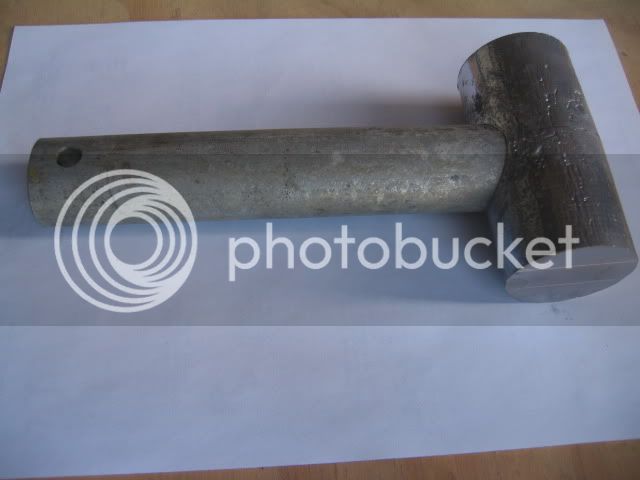B
Bogstandard
Guest
WARNING - BEFORE GOING ANY FURTHER, PART OF THIS POST IS ABOUT USING MOLTEN OR HOT METAL. IF YOU DO NOT KNOW ALL THE SAFETY PRECAUTIONS AND CORRECT PROTECTIVE EQUIPMENT THAT THIS ENTAILS, AND YOU ARE NOT WILLING TO FOLLOW ALL THE CORRECT PROCEDURES WHEN HANDLING MOLTEN OR HOT METALS, DO NOT TRY ANY OF THE HOT METAL PROCEDURES MENTIONED IN THIS POST. THE SAFETY PRECAUTIONS IN THIS POST MIGHT NOT BE CORRECT, IT IS UP TO YOURSELF TO FAMILIARISE YOURSELF WITH THE CORRECT ONES
NO-ONE ON THIS SITE CAN BE HELD RESPONSIBLE FOR ANY OF YOUR ACTIONS IF YOU HURT YOURSELF.
THIS WARNING WAS ADDED BY ADMINISTRATION OF THIS SITE.
Yesterday I was replying to one of my posts and Mel (Lugnut) shamed me into doing this post.
He asked what I had been hitting with my lead hammer, and I realised that they were well past their sell by date.
Oh! The shame of it.

I cast my own lead hammers, the reason being is because they are getting more difficult and expensive to buy, and the ones you can get are usually too heavy for what I want.
So this shows how I make my approx. 1lb hammers.
I made this mould many years ago, and has cast dozens of these little hammer heads.



If I was making a new mould I would do it as shown in this sketch.

As you can see from the sketch, I have force fitted an aluminium plug up the shaft, this stops the molten lead from running out thru the handle.
If you didn't want to recess the bottom plug in the mould, you could just screw a plate onto the bottom
This next shot shows the end melted off (and reused) and shows the holes and bits of threaded rod put thru a couple of them, I have never had a head come loose, and this is due to these little measures. When it is mounted into the mould, don't push it all the way in until it reaches the opposite side, leave about 1/4" gap.

All new persuaders, one on the lathe and one for the miller.

The one on the right shows signs of cooling as it was poured, so on the other I warmed up the mould just a little bit more.
When using lead hammers for 'bedding' things down I don't hold it by the handle but by the head. If used properly you can 'thump' a finished face and it will not do any damage at all. The reason they get into such a bad state is that I use them for releasing the tapers on my miller. I'm not worried though, because an hour later I can have two brand new ones.
John
NO-ONE ON THIS SITE CAN BE HELD RESPONSIBLE FOR ANY OF YOUR ACTIONS IF YOU HURT YOURSELF.
THIS WARNING WAS ADDED BY ADMINISTRATION OF THIS SITE.
Yesterday I was replying to one of my posts and Mel (Lugnut) shamed me into doing this post.
He asked what I had been hitting with my lead hammer, and I realised that they were well past their sell by date.
Oh! The shame of it.

I cast my own lead hammers, the reason being is because they are getting more difficult and expensive to buy, and the ones you can get are usually too heavy for what I want.
So this shows how I make my approx. 1lb hammers.
I made this mould many years ago, and has cast dozens of these little hammer heads.



If I was making a new mould I would do it as shown in this sketch.

As you can see from the sketch, I have force fitted an aluminium plug up the shaft, this stops the molten lead from running out thru the handle.
If you didn't want to recess the bottom plug in the mould, you could just screw a plate onto the bottom
This next shot shows the end melted off (and reused) and shows the holes and bits of threaded rod put thru a couple of them, I have never had a head come loose, and this is due to these little measures. When it is mounted into the mould, don't push it all the way in until it reaches the opposite side, leave about 1/4" gap.

All new persuaders, one on the lathe and one for the miller.

The one on the right shows signs of cooling as it was poured, so on the other I warmed up the mould just a little bit more.
When using lead hammers for 'bedding' things down I don't hold it by the handle but by the head. If used properly you can 'thump' a finished face and it will not do any damage at all. The reason they get into such a bad state is that I use them for releasing the tapers on my miller. I'm not worried though, because an hour later I can have two brand new ones.
John







